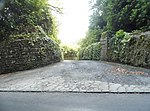Winterfold House
Winterfold House is one of the few private country properties to be designed by London architect Edward Blakeway I'Anson, F.R.I.B.A., M.A. Cantab of St Laurence Pountney Hill, E.C. He was the elder son of Edward I'Anson JP, born in London and educated at Cheltenham College and Cambridge University. He followed his father's profession and was architect and surveyor to St Bartholomew's Hospital in London. The Architect’s practice continued by him was one of the oldest established in the country, and many of the finest buildings in the City of London including the new Corn Exchange in Mark Lane, London are of his design. He was Master of the Worshipful Company of Merchant Taylors in 1908. In partnership with his father Edward I'Anson they had earlier made a successful major refurbishment to Fetcham Park House Surrey.
Excerpt from the Wikipedia article Winterfold House (License: CC BY-SA 3.0, Authors).Winterfold House
Barhatch Lane, Waverley
Geographical coordinates (GPS) Address Nearby Places Show on map
Geographical coordinates (GPS)
| Latitude | Longitude |
|---|---|
| N 51.1666 ° | E -0.4664 ° |
Address
Barhatch Lane
GU6 7NJ Waverley
England, United Kingdom
Open on Google Maps






